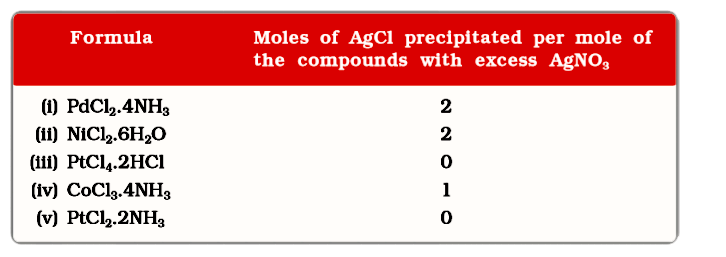Complete Solutions to Solved Examples of chapter COORDINATION COMPOUNDS of Class 12 book with complete answers and questions
| Class 12 | CHEMISTRY |
| Chapter | COORDINATION COMPOUNDS |
| NCERT | Solved Examples |
| Number Of Questions | 7 |
| Academic Year | 2023-24 |
On the basis of the following observations made with aqueous solutions, assign secondary valences to metals in the following compounds:
 05:34View Solution
05:34View SolutionWrite the formulas for the following coordination compounds:
(a) Tetraa mmineaqua chlorido cobalt (III) chloride
(b) Potassium tetrahydroxid ozincate (II)
(c) Potassium trioxalato aluminate (III)
(d) Dichloridobis (ethane-1,2-diamine) cobalt (III)
(e) Tetra carbonyl nickel (0)05:15View SolutionWrite the IUPAC names of the following coordination compounds:
(a)`[Pt(NH_(3))_(2)Cl(NO_(2))]`
(b) `K_(3)[Cr(C_(2)O_(4))_(3)]`
(c) `[CoCl_(2)(en)_(2)]Cl`
(d) `[Co(NH_(3))]Cl`
(e) `Hg[Co(SCN)_(4)]`07:42View SolutionWhy is geometrical isomerism not possible in tetrahedral complexes having two different types of unidentate ligands coordinated with central metal ion ? .
03:32View SolutionDraw structures of geometrical isomers of `[Fe(CN)_(4)(NH_(3))_(2)]^(Θ)` .
01:55View SolutionOut of the following two coordination entities Which is chiral (optically active)
(a) `cis-[CrCI_(2)(OX)_(2)]^(3-)`
(b) `trans -[CrCI_(2)(OX)_(2))]^(3-)` .03:41View SolutionThe spin only magnetic moment value of `[MnBr_(4)]^(2-)` ion is `5.9BM` On the basis of `VBT` Predict the hybridisation and geometry of `[MnBr_(4)]^(2-)` ion ` .
02:48View Solution
Solved Examples questions and complete solutions for chapter COORDINATION COMPOUNDS of NCERT CHEMISTRY(HINGLISH) of Class 12
